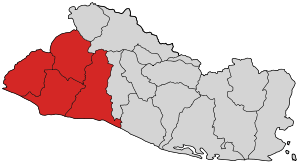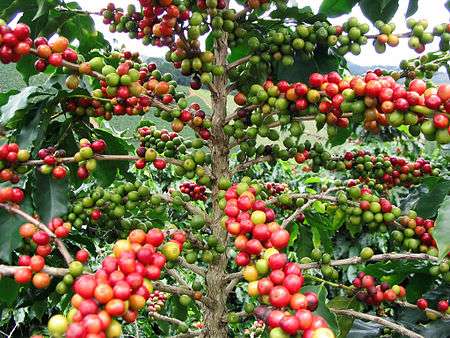1932 Salvadoran peasant massacre
Coordinates: 13°39′58″N 89°09′58″W / 13.666°N 89.166°W
| 1932 Salvadoran peasant uprising | |||||||
|---|---|---|---|---|---|---|---|
 Map of the Salvadoran districts affected by the uprising. | |||||||
| |||||||
| Belligerents | |||||||
| Salvadoran rebels |
| ||||||
| Commanders and leaders | |||||||
|
Feliciano Ama Francisco Sánchez |
Maximiliano Hernández Martínez José Tomás Calderón Osmín Aguirre y Salinas Salvador Ochoa Saturnino Cortez | ||||||
| Casualties and losses | |||||||
| between 10,000 and 40,000,[1] 25,000 dead[2] | |||||||
The 1932 Salvadoran peasant massacre occurred on January 22 of that year, in the western departments of El Salvador when a brief peasant-led rebellion was suppressed by the government, then led by Maximiliano Hernández Martínez. The Salvadoran army, being vastly superior in terms of weapons and soldiers, executed those who stood against it. The rebellion was a mixture of protest and insurrection and ended in ethnocide,[3] claiming the lives of anywhere between 10,000 and 40,000[4] peasants and other civilians, many of them indigenous people.[5]
Background

Social unrest in El Salvador had begun to grow in the 1920s, primarily because of the perceived abuses of the political class, and the broad social inequality between the landowners and the peasants,.[6][7] The policies of the latifundia had left 90 percent of the country's land in the hands of 14 families, 'los catorce', who used the land for the cultivation of the cash-crop coffee.[8] The unrest was only strengthened by the tremendous drop in the price of the coffee bean during the Great Depression accompanied by growing unemployment rates.
The national coffee-growing industry arose from the accumulation of riches of a small group of landowners and merchants[7][9] who had purchased large portions of land and employing a great number of peasants, many of them indigenous.[10]
Politically, El Salvador had been ruled since 1871 by economic liberal elites who had established what became known as the "Coffee Republic", which had given the country a long period of comparative stability and a liberal constitution in 1886. By World War I, the presidency rotated effectively between the Meléndez and Quiñónez families in quasi-dynastic succession. In 1927, Pío Romero Bosque was elected President and embarked on political liberalisation that led to what was arguably the first free election in Salvadoran history in 1931, won by the reformist Arturo Araujo. However, this period of pluralist democracy was not to last.
The coup
Unrest spread among military officers. In December 1931, with the collapse of coffee prices, the military's dissatisfaction peaked. A group of young officers, led by vice president Maximiliano Hernández Martínez, staged a coup and ousted Araujo. Araujo fled the country and Martínez assumed power.
The uprising
Though Martínez's rule may have satisfied the military, popular discontent continued to build and the government's opponents continued to agitate. Within weeks, communists, believing the country was ready for a peasant rebellion, were plotting an insurrection against Martínez. However, the government learned of the plot and arrested most of the ringleaders.
Nonetheless, actual fighting broke out on January 22, 1932. Rebels led by the communist party and Agustín Farabundo Martí, Mario Zapata and Alfonso Luna, attacked government forces with support that was largely from Pipil Indians in the western part of El Salvador. Within three days, they had succeeded in taking control of several towns, disrupting supply lines to many of the country’s towns and villages, and attacking a military garrison. With their superior training and technology, the government troops needed only a few days to defeat the rebels. While the rebels killed fewer than 100 people, the military retaliated with great force. The government responded to the uprising with great brutality with between 10,000 and 40,000 peasants, including Martí dying in the uprising. As the killings particularly targeted people of indigenous appearance, dress, or language,[11][12][13] in the decades that followed, Salvadoran indigenous peoples increasingly abandoned native dress and languages from fear of further reprisals.[11][12]
The towns of Nahuizalco, Juayua, Apaneca and Izalco were assaulted by the army. Feliciano Ama, an Indian leader, was hanged and this event was shown on postage stamps of the time. Following the Matanza, from 1932 to 1979, military officers held the presidency, with some presidents using more repression than others. Some of the perceived problems of El Salvador included an unfair minimum wage, repression against student and general demonstrations, and election fraud.
See also
Footnotes
- ↑ University of California, San Diego (2001). "El Salvador elections and events 1902–1932". Archived from the original on May 21, 2008. Retrieved August 12, 2008.
- ↑ http://html.rincondelvago.com/oligarquia-cafetalera-en-santa-tecla-y-santa-ana.html
- ↑ Payés, Txanba (January 2007). "El Salvador. La insurrección de un pueblo oprimido y el etnocidio encubierto" (in Spanish). Archived from the original on July 31, 2008. Retrieved August 11, 2008.
- ↑ University of California, San Diego (2001). "El Salvador elections and events 1902–1932". Archived from the original on May 21, 2008. Retrieved August 12, 2008.
- ↑ CISPES (January 27, 2007). "La sangre de 1932" (in Spanish). Retrieved August 11, 2008.
- ↑ "El Salvador en los años 1920–1932" (in Spanish). Archived from the original on September 15, 2008. Retrieved September 14, 2008.
- 1 2 Armed Forces of El Salvador. "Revolución 1932" (in Spanish). Archived from the original on June 19, 2008. Retrieved September 14, 2008.
- ↑ Uppsala Conflict Data Program Conflict Enclyclopedia, El Salvador, In Depth, Negotiating a settlement to the conflict, http://www.ucdp.uu.se/gpdatabase/gpcountry.php?id=51®ionSelect=4-Central_Americas#, viewed on May 24, 2013
- ↑ Moreno, Israel (December 1997). "El Salvador: Un paisito en peligro de extinción". Revista Envío (in Spanish). Universidad Centroamericana (189). Retrieved September 14, 2008.
- ↑ de La Rosa Municio, Juan Luis (January 2006). "El Salvador: Memoria histórica y organización indígena" (in Spanish). Archived from the original on October 8, 2008. Retrieved September 14, 2008.
- 1 2 "El Salvador: before the war," Enemies of War, PBS companion web site for the documentary film of the same name. Retrieved May 20, 2013.
- 1 2 Virginia Garrard-Burnett. "1932: Scars of memory (Cicatriz de la memoria) (film review), The American Historical Review, 109:2 (April 2004), pp. 575-576. Retrieved from the JSTOR database May 20, 2013.
- ↑ Deborah Decesare. "Timeline: the massacre in El Salvador," companion website to the documentary film Destiny's Children. Retrieved May 20, 2013.
Further reading
- Gould, Jeffrey L. (2008), To Rise in Darkness: Revolution, Repression, and Memory in El Salvador, 1920–1932, Duke University Press, ISBN 978-0-8223-4228-1
- Alegría, Claribel (1989). Ashes of Izalco: a novel. Willimantic, CT : New York, NY: Curbstone Press ; Distributed to the trade by the Talman Co. ISBN 0915306840.
References
- Ministerio de Educación de la República de El Salvador (1994). Historia de El Salvador, tomo II (in Spanish). San Salvador: MINED.
- de Bry, John (18 May 2004). "Review of 1932 – Scars of Memory (Cicatriz de la Memoria), A film by Jeffrey Gould and Carlos Henriquez Consalvi". Kacike. [On-line Journal]. ISSN 1562-5028. Archived from the original on July 21, 2006. Retrieved June 30, 2006.